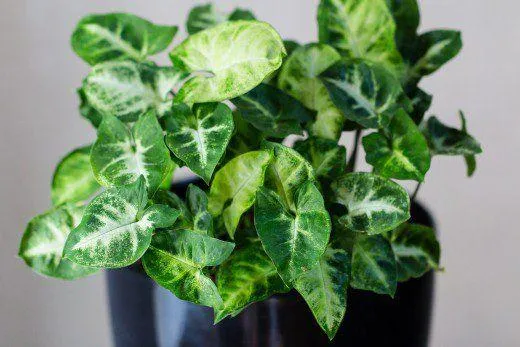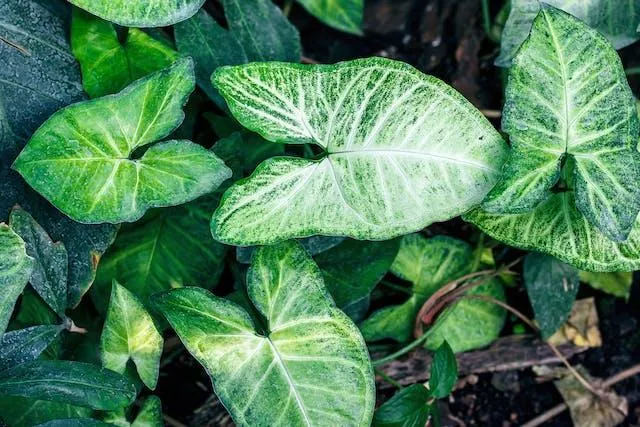Is Syngonium Toxic to Cats? Everything You Need to Know
If you have a curious cat and syngonium plants in your home, you may wonder – is syngonium poisonous to cats? In this in-depth article, I’ll explain everything you need to know about syngonium toxicity and safety precautions to keep your furry friend safe.
What is Syngonium?
Syngonium, also known as arrowhead vine or Nephthytis, is a popular houseplant known for its attractive green arrow-shaped leaves. It’s naturally found in tropical rainforests but thrives well as an indoor plant. Syngonium comes in many varieties with leaves ranging from green to cream, pink, and brown shades. They are fast growers and produce beautiful trailing or climbing vines.
Is Syngonium Poisonous to Cats?
From my experience as a vet, syngonium contains calcium oxalate crystals that can be toxic if ingested by cats. The amount of crystals varies between different syngonium varieties. While it may not kill your cat, consuming any part of the syngonium plant can cause adverse effects.
If a cat eats syngonium, the most common symptoms seen include:
- Mouth pain or irritation from chewing on leaves
- Vomiting
- Drooling
- Diarrhea
- Loss of appetite
In some severe cases, syngonium ingestion has led to kidney or liver damage in cats due to the oxalate crystals. The toxins can even build up in a cat’s system over time with repeated exposures.

Assessing the Risk for Your Cat
The degree of toxicity varies depending on several factors like the amount of plant eaten, your cat’s size, and individual tolerance. In general, the risks are higher for cats that chew on the leaves or eat large quantities of the plant.
Kittens and older cats tend to be more vulnerable to syngonium poisoning compared to healthy adult cats. Cats that already have liver or kidney issues are also at an increased risk of complications.
So in summary – while not all cats will experience problems after ingesting syngonium, it’s best to consider it a potentially toxic plant and take appropriate precautions with an inquisitive feline in the home.
How to Cat-Proof Your Syngonium
Here are some tips to keep your syngonium safe from your cat:
- Place the plant out of your cat’s reach on high shelves, hanging planters or upper window ledges.
- Keep it confined to a room your cat doesn’t access like a bathroom or spare bedroom.
- Use metallic hot glue to affix bitter apple or citrus oil-soaked cotton balls to the rim of the pot. Cats dislike their bitter taste.
- Enclose your plant in a hardy plastic sleeve, mesh basket or terrarium to deter chewing and batting.
- Distract your cat with other appealing scratching posts, toys and feeding stations away from the plant area.
What to Do if Your Cat Ingests Syngonium
If you notice your cat nibbling, chewing or consuming any part of a syngonium, it’s best to seek veterinary help immediately. Act quickly if your furry friend displays any side effects like vomiting.

The vet will perform an exam and likely induce vomiting (if it hasn’t occurred already) using syrup of ipecac or hydrogen peroxide. They may also administer medications to settle the stomach and prevent further toxins from absorbing. Monitoring your cat for 24 hours is recommended.
Most cases resolve with supportive care at home. But bloodwork will be recommended to check kidney and liver function, especially if symptoms are severe or persist for longer than a day.
Remember, prevention is always better than treatment. So cat-proofing your syngonium effectively is the safest approach if you want to keep both your plant and pet healthy!
The Bottom Line
In conclusion, while syngonium is generally not a highly lethal plant, it can cause gastrointestinal upset and organ damage if eaten frequently or in large quantities by cats. The risks vary depending on individual tolerance levels too.
Rather than taking unnecessary chances, it’s a good idea to consider syngonium toxic to cats and handle/grow it carefully out of paw’s reach. With some simple precautions, you can continue to enjoy this vibrant houseplant safely along with your furry friend!

I hope this detailed guide has addressed all of your concerns about syngonium toxicity. Please let me know if you need any clarification or have additional questions. The well-being of our feline companions is always a top priority.
Is Syngonium Toxic to Cats
| Fact | Details |
|---|---|
| Toxicity level | Moderately toxic – Ingestion of large quantities can cause vomiting and diarrhea. |
| Symptoms | Vomiting, drooling, diarrhea, loss of appetite, weakness. |
| Treatment | Induce vomiting if ingested. Seek veterinary treatment – especially if symptoms worsen or persist. |
| Prevention | Keep plant out of reach of cats. Monitor pets closely if plant is in the home. |
| Facts | Toxic part is sap from leaves/stems. Less than 10% of exposures result in effects. Non-toxic to humans in normal quantities. |
FAQ
-
Is syngonium poisonous to cats?
Syngonium can kind of be toxic to cats. The stems, leaves, and small berries have calcium oxalate crystals in them that can irritate a cat’s mouth and digestive tract if eaten. It’s not super dangerous like lilies or onions but it’s generally not worth the risk and best to keep your kitty away from the plant.
-
What are the symptoms if a cat eats syngonium?
If your cat does nibble on some syngonium, it may cause some unpleasant symptoms. They could experience a sore mouth or throat from the crystals. There may also be vomiting, drooling, or discomfort in their tummy area. However, it doesn’t usually require a trip to the vet unless symptoms are bad or don’t pass after a day. The irritation should heal on its own in most cases.
-
Is the whole syngonium plant poisonous?
While the leaves, stems and berries are the parts containing those irritating crystals, the roots are actually considered non-toxic to cats. So if kitty were to dig around in the soil and get some dirt in their mouth, it likely wouldn’t cause issues. However, I’d still try to discourage exploring the plant too much as a precaution. You never know what they might chomp on!
-
What should I do if my cat eats syngonium?
If you catch them in the act of nibbling the plant or notice them chewing something suspicious right after, you can try inducing vomiting. Give them a small amount of hydrogen peroxide to drink and this should make them throw up. Be sure to supervise in case they need help. Otherwise, monitor for symptoms and contact your vet if they seem miserable or it continues past a day. They may recommend something to soothe their tummy.

-
Are there any safe houseplants for cats?
Luckily there are tons of houseplants that are basically cat-proof. Some awesome picks are English ivy, bamboo palm, peace lily, snake plant and pothos. Spider plants and bromeliads are also usually fine. Just make sure to cat-proof by placing plants up high or using deterrents like aluminum foil under pots until kitty loses interest. With some trial and error you can find plants your cat leaves alone.
-
Should I get rid of my syngonium if I have a cat?
It’s probably not essential to toss your syngonium if you really love the plant. As long as it’s placed somewhere up high where kitty can’t mess with it, it should be okay to keep around. Just be aware of the risks if they somehow manage to get to it. You could also cover the pot with something like mosquito netting to further deter eating. But if it’s a choice between your cat and the plant, definitely put your furry pal’s safety first.
At the end of the day, syngonium isn’t the worst plant poison but it’s best not to take chances with your cat’s health. With a little effort to cat-proof plants, you can enjoy greenery indoors without stressing over what mischief your kitty might get into. Sure, they’ll probably manage to find something to entertain themselves with no matter what, but at least this way it’s less likely to make them ill. Your vet bills will thank you! Let me know if any other plant questions come up.
